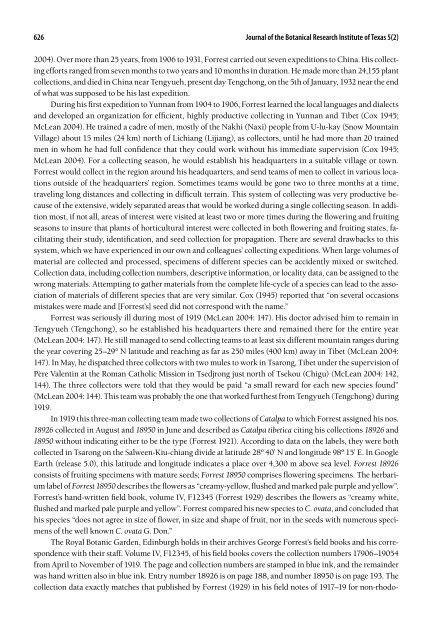J.H. Kirkbride, Jr. R.T. Olsen - Brit
J.H. Kirkbride, Jr. R.T. Olsen - Brit
J.H. Kirkbride, Jr. R.T. Olsen - Brit
You also want an ePaper? Increase the reach of your titles
YUMPU automatically turns print PDFs into web optimized ePapers that Google loves.
626 Journal of the Botanical Research Institute of Texas 5(2)<br />
2004). Over more than 25 years, from 1906 to 1931, Forrest carried out seven expeditions to China. His collecting<br />
efforts ranged from seven months to two years and 10 months in duration. He made more than 24,155 plant<br />
collections, and died in China near Tengyueh, present day Tengchong, on the 5th of January, 1932 near the end<br />
of what was supposed to be his last expedition.<br />
During his first expedition to Yunnan from 1904 to 1906, Forrest learned the local languages and dialects<br />
and developed an organization for efficient, highly productive collecting in Yunnan and Tibet (Cox 1945;<br />
McLean 2004). He trained a cadre of men, mostly of the Nakhi (Naxi) people from U-lu-kay (Snow Mountain<br />
Village) about 15 miles (24 km) north of Lichiang (Lijiang), as collectors, until he had more than 20 trained<br />
men in whom he had full confidence that they could work without his immediate supervision (Cox 1945;<br />
McLean 2004). For a collecting season, he would establish his headquarters in a suitable village or town.<br />
Forrest would collect in the region around his headquarters, and send teams of men to collect in various locations<br />
outside of the headquarters’ region. Sometimes teams would be gone two to three months at a time,<br />
traveling long distances and collecting in difficult terrain. This system of collecting was very productive because<br />
of the extensive, widely separated areas that would be worked during a single collecting season. In addition<br />
most, if not all, areas of interest were visited at least two or more times during the flowering and fruiting<br />
seasons to insure that plants of horticultural interest were collected in both flowering and fruiting states, facilitating<br />
their study, identification, and seed collection for propagation. There are several drawbacks to this<br />
system, which we have experienced in our own and colleagues’ collecting expeditions. When large volumes of<br />
material are collected and processed, specimens of different species can be accidently mixed or switched.<br />
Collection data, including collection numbers, descriptive information, or locality data, can be assigned to the<br />
wrong materials. Attempting to gather materials from the complete life-cycle of a species can lead to the association<br />
of materials of different species that are very similar. Cox (1945) reported that “on several occasions<br />
mistakes were made and [Forrest’s] seed did not correspond with the name.”<br />
Forrest was seriously ill during most of 1919 (McLean 2004: 147). His doctor advised him to remain in<br />
Tengyueh (Tengchong), so he established his headquarters there and remained there for the entire year<br />
(McLean 2004: 147). He still managed to send collecting teams to at least six different mountain ranges during<br />
the year covering 25–29° N latitude and reaching as far as 250 miles (400 km) away in Tibet (McLean 2004:<br />
147). In May, he dispatched three collectors with two mules to work in Tsarong, Tibet under the supervision of<br />
Père Valentin at the Roman Catholic Mission in Tsedjrong just north of Tsekou (Chigu) (McLean 2004: 142,<br />
144). The three collectors were told that they would be paid “a small reward for each new species found”<br />
(McLean 2004: 144). This team was probably the one that worked furthest from Tengyueh (Tengchong) during<br />
1919.<br />
In 1919 this three-man collecting team made two collections of Catalpa to which Forrest assigned his nos.<br />
18926 collected in August and 18950 in June and described as Catalpa tibetica citing his collections 18926 and<br />
18950 without indicating either to be the type (Forrest 1921). According to data on the labels, they were both<br />
collected in Tsarong on the Salween-Kiu-chiang divide at latitude 28º 40’ N and longitude 98º 15’ E. In Google<br />
Earth (release 5.0), this latitude and longitude indicates a place over 4,300 m above sea level. Forrest 18926<br />
consists of fruiting specimens with mature seeds; Forrest 18950 comprises flowering specimens. The herbarium<br />
label of Forrest 18950 describes the flowers as “creamy-yellow, flushed and marked pale purple and yellow”.<br />
Forrest’s hand-written field book, volume IV, F12345 (Forrest 1929) describes the flowers as “creamy white,<br />
flushed and marked pale purple and yellow”. Forrest compared his new species to C. ovata, and concluded that<br />
his species “does not agree in size of flower, in size and shape of fruit, nor in the seeds with numerous specimens<br />
of the well known C. ovata G. Don.”<br />
The Royal Botanic Garden, Edinburgh holds in their archives George Forrest’s field books and his correspondence<br />
with their staff. Volume IV, F12345, of his field books covers the collection numbers 17906–19054<br />
from April to November of 1919. The page and collection numbers are stamped in blue ink, and the remainder<br />
was hand written also in blue ink. Entry number 18926 is on page 188, and number 18950 is on page 193. The<br />
collection data exactly matches that published by Forrest (1929) in his field notes of 1917–19 for non-rhodo-
















